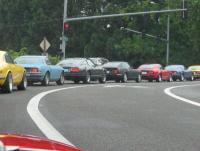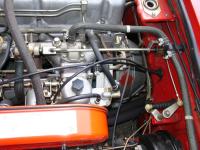Everything posted by Arne
-
Dirty fluid in clutch resivoir ?
The failure point for this type of problem (both for clutch and brake hydraulics) is typically the master cylinder. It happens more often with brakes than clutch, but both are susceptible. So removing the downstream parts doesn't help. In the case of the brakes especially, you don't want to press the pedal (and therefore the master cylinder piston) farther than its normal amount of travel. Doing that will run the piston seals over the sludge that will have built up inside the cylinder bore. So your best bet is to not stoke the pedal if possible - use either gravity bleeding, vacuum bleeding or a pressure bleeder. Anything that will allow you to change the fluid without having to push the pedal.
-
Dirty fluid in clutch resivoir ?
I'll clarify that advice a bit. If you have been flushing the clutch (or brakes) regularly from new, that's fine. But if they have never been flushed, or it has been many years since the last flush, don't start now. What happens is that crud will build up in the cylinders over time. If you flush regularly from new, the crud is cleaned out regularly and kept to a minimum. But if the crud is allowed to build up and harden over several years, a flush won't remove it but will only move it around to where the piston seals have to run over it and you suddenly have a failure shortly after the flush.
-
Left Inner Tie Rod for 240z no longer available
I seem to recall hearing at some point that the outers that are made to match the universal inners are threaded to match, not threaded L and R like the originals. I recall someone saying that you need to buy the inners and outers as matching sets from the same manufacturer. But I don't know from personal experience if that is or was ever true.
-
started body work on my 280
For people only attending on Sunday (the day of the actual show), a number of us typically meet at one of the I-5 rest areas and convoy in the final 10 miles or so.
-
Are more 280 owners noticing difficult restart when engine is hot?
I do. But we don't salt the roads here...
-
Where to check for rust??
Apparently he bought a 280Z.http://www.classiczcars.com/forums/album.php?albumid=330&pictureid=2315
-
280zx alternator upgrade issue
No red idiot light for the charging system on a 240Z. Just the ammeter.
-
Gasoline additive for desert climate..........
If ethanol is the issue, you may want to look for a station that sells what the boat crowd calls "the Clear", which here in Oregon is 92-93 octane without ethanol. Oregon now mandates 10% ethanol in motor vehicles, although cars over 25 years old are still allowed to use the clear if they can find it. Generally only available at stations near boating destinations here. Not very convenient. Might be worth testing a tank, even if it's not convenient for all the time use.
-
Taillight swap?
There are holes in the rear panel of the 260Z/280Z for the backup lights that would need to be sealed in some way.
-
What's Grounding Here?
There's been other threads on that question here, the answer has been mixed. Sometime in late '72 or so?
-
What's Grounding Here?
Depends on the year and which style tach you have. The early 240Zs with the so-called "4-wire" tach will not run (without a jumper wire) if the tach is disconnected. I don't believe that is true for the cars with the "3-wire" tachs.
-
1971 door seals
Guy, the later one-piece seals are what the ones that come in the Precision kit are trying to replicate. As I noted above, the crimp part is too big to fit nicely under the black scuff plate. I don't know if original Nissan seals for the later cars would have the same issue.
-
71 or 72 dizzy in stock Series 1
- MSA seatbelts wont fit
That's about 6'5" to 6'6" for the metric challenged. Tall, yes. But I don't even think my car's seats go back that far.- 71 or 72 dizzy in stock Series 1
I don't see any problem using any of the early single-point dizzies in your car. The advance curve was slightly different on the later dizzies, but not by so much that you couldn't tweak the static timing a bit to compensate.- My car is finally home!
If you didn't ask for those holes to be filled, I'd ask the shop for assistance in re-creating them. You should not have to risk damaging the new paint to undo something the shop did that they weren't supposed to do.I'm certain that between all the 240Zs on this site, we can find someone whose emblems are not installed so we can make templates for you.- RPM at highway speeds in 4th gear?
Well, yes and no. Pumping it in is that simple. But nowhere in the Nissan manuals does it state that you pump it in until it starts to dribble out. The factory always states that "the proper (measured) amount of lube should be added".It has been my experience with the early-style (Type A) transmission in the '70-71 240Z that if you fill until it dribbles out, you will have overfilled it by 1/4 to 1/2 quart or liter. If you do this, you risk having the excess leak past the front input seal. I wonder if this might be true for the differential as well. I would strongly recommend not overfilling it, but to pump in the specified amount only.- Switching '73 Carbs to '70 Carbs: Have ?'s
No. You can use the same manifolds now on the car. If the carbs you will be installing are from either a '70 or '71 (known as "4 screw" for the number of screws holding the dome to the body), you will need to bypass the manifold pre-heat (coolant lines), but that's all. Not sure on this one, but I think the '73 choke cables can be modified to work. In any case, the cables for a '70 will be considerably too short due to the difference in how the early cables were routed.- Help on parts identification
No need for two separate threads on this topic. I merged them- RPM at highway speeds in 4th gear?
Yup, that'll make it worse. Since we don't know how fast everyone else is driving, it's hard to reverse calculate the ratio. But I'd guess that a 3.9 is probably close. Not the best for use with a four speed, that's certain.- RPM at highway speeds in 4th gear?
With stock size tires, a 4 speed 240Z with the stock 3.36:1 ratio should be turning about 2850 RPM or so. Tire size can have a significant effect as well. What size tires do you have on the rear?- Installing Water Temperature Sensor
Pipe tape can tend to insulate the sensor from grounding properly, causing gauge inaccuracy.- Seat restoration
The black finish on the original recliner mechanisms in my late '71 is/was satin.- Major cost to repair?
Oil from a rear main seal rarely gets on the clutch. The oil drips down the rear engine plate. The clutch is on the flywheel, which is between the leak and the clutch. I really don't know why the mechanic would tell you that he thinks it is getting on the clutch, unless he wants to make it sound important enough to be certain you have the job done. Price seems a bit steep to me as well. While I'm with Gary in that I would do that myself, I did pay a local German car specialist shop to replace the rear main seal on the family BMW. Same basic job, but the BMW is more involved. That shop (who specializes in BMW, Mercedes and Porsche repair) charged me $700. Can't see that the far simpler Z should be more than the BMW.- Digital Throttle Behavior
- MSA seatbelts wont fit
Important Information
By using this site, you agree to our Privacy Policy and Guidelines. We have placed cookies on your device to help make this website better. You can adjust your cookie settings, otherwise we'll assume you're okay to continue.






